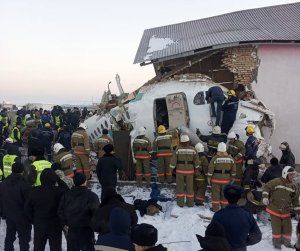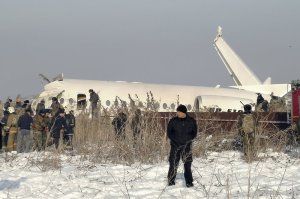KAZAKHSTAN — At least 12 people were killed when a plane carrying 93 passengers and five crew members crashed shortly after takeoff near the city of Almaty in Kazakhstan on Friday morning.
The plane “lost altitude after takeoff and broke through a concrete fence,” before colliding with a two-story building at approximately 7:22 a.m., local time, according to the Almaty airport authority.
Flight Z2100, a Fokker 100 aircraft operated by Kazakhstan-based carrier Bek Air, was scheduled to fly from Almaty, the country’s largest city, to the capital Nur-Sultan.
The captain of the plane was among the 12 dead, the emergency committee of the internal affairs ministry announced. Fifty people, including at least six children, were taken to nearby hospitals for treatment with various degrees of injuries. The Almaty airport authority said at least 17 of those hospitalized were in an “extremely serious condition.”
Earlier the news agency Kazinform reported that at 15 had been killed, but an Almaty healthcare department spokeswoman told Reuters that the higher figure was the result of confusion on the ground. The flight was carrying 93 passengers and five crew, according to preliminary data, the airport authority said, correcting an earlier statement that said 95 passengers and five crew were on board.

Data provided by Flightradar24 indicated the plane crashed 19 seconds after takeoff, approximately 5 kilometers (3.1 miles) from the airport. Videos and images of the crash site near Kyzyl Tu village show the damaged plane broken into several parts, with the nose embedded in a small partially-collapsed house.
Parts of the fuselage appeared to be relatively intact, however, raising hopes that many of those on board had survived the initial impact.
Rescue operations in the Central Asian state began immediately with 40 ambulance crews deployed to provide medical care, the Kazakhstan aviation committee said in a statement. Emergency responders at the scene could be seen evacuating passengers and crew members from the wreckage. There were no reports of a fire following the crash.
The cause of the incident was under investigation, the aviation committee said in a statement published online. As a precautionary measure, authorities said that all flights using the Fokker 100 aircraft would be temporarily suspended until the circumstances of the crash were made clear. The Fokker 100 is a medium sized twin-turbofan jet often used for short haul flights.
The Fokker 100 aircraft involved in the crash went into operation in 1996, according to the Kazakhstan Aviation Committee.
“The (plane) was 23 years old, but still a rugged airplane and has a very good service record,” Geoffrey Thomas, editor in chief of aviation website airlineratings.com, told CNN. “Fokker built very good airplanes (with) a high degree of focus on structural integrity, which is why this airplane has not been broken up into more pieces.”

“The absence of a fire makes an enormous difference, and that is a major factor in the survivability of this, coupled with the strength of the fuselage. I am surprised that a fire did not break out. That is probably because the fuel tanks and the wings remain intact and didn’t rupture. Again, testament to the structure of the aircraft.”
Temperatures dipped to minus 7 degrees Celsius (20 Fahrenheit) at Almaty airport on Friday, according to aviation website Flightstats.com.
David Soucie, a former Federal Aviation Administration safety inspector based in Hawaii, told CNN he suspected the freezing conditions may have been a factor in the crash.
“The airplane is pretty much a tank. That airplane has been around for a long time, if properly maintained, that aircraft could continue to fly for many more years yet,” he said. “It’s too early to state anything about maintenance or anything else on the aircraft, I don’t want to jump ahead of the game here. But at this point, my suspect would be weather being the biggest factor.”
In a tweet, Kazakh President Kassym-Jomart Tokayev expressed condolences to the families of the victims and warned that those responsible for the crash would face “severe punishment in accordance with the law.”
He also declared that on Saturday there would be a nationwide day of mourning.
Bek Air was added to the European Union’s list of banned air carriers in 2009 but was removed in December 2016, according to the Aviation Safety Network (ASN), a website run by the independent nonprofit Flight Safety Foundation.
A Bek Air flight carrying 116 passengers and five crew from Kazakhstan’s Kzyl-Orda airport made an emergency landing at Astana airport on March 27, 2016, according to ASN. No injuries or fatalities were reported in that incident.





































